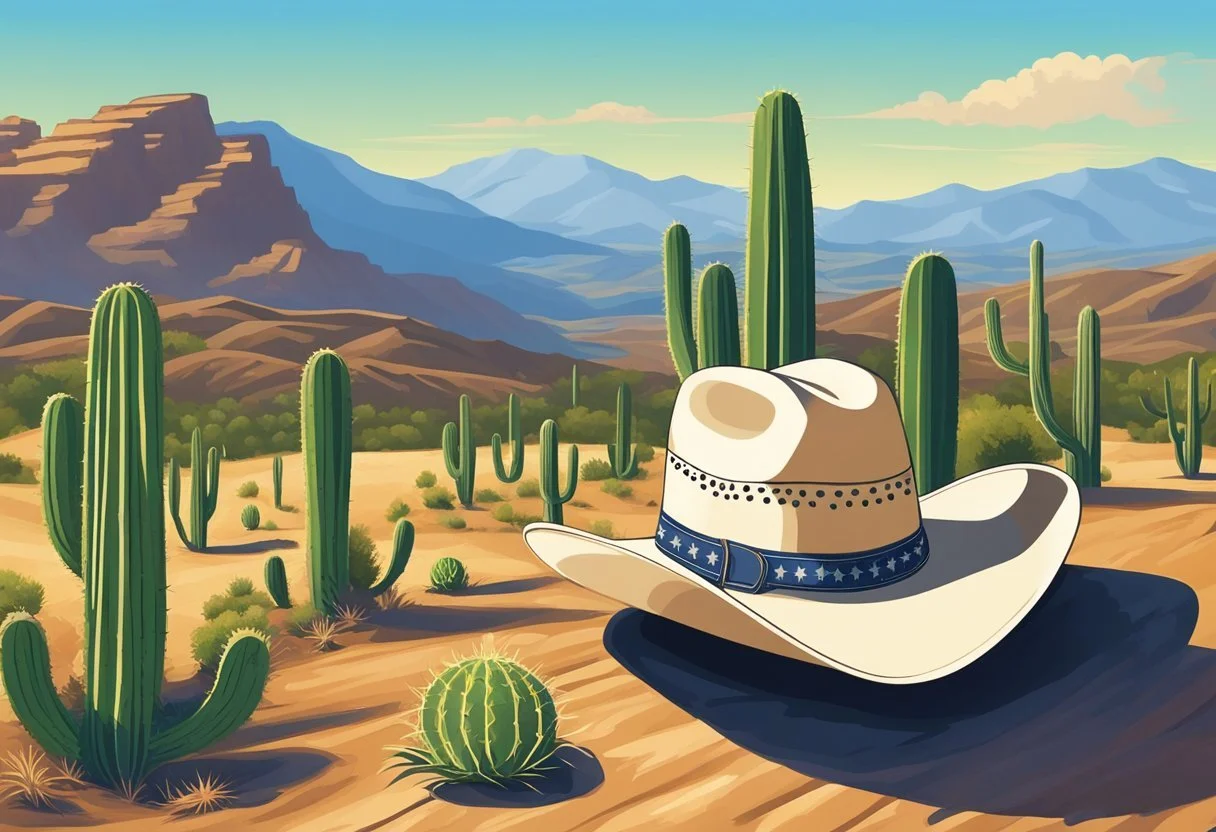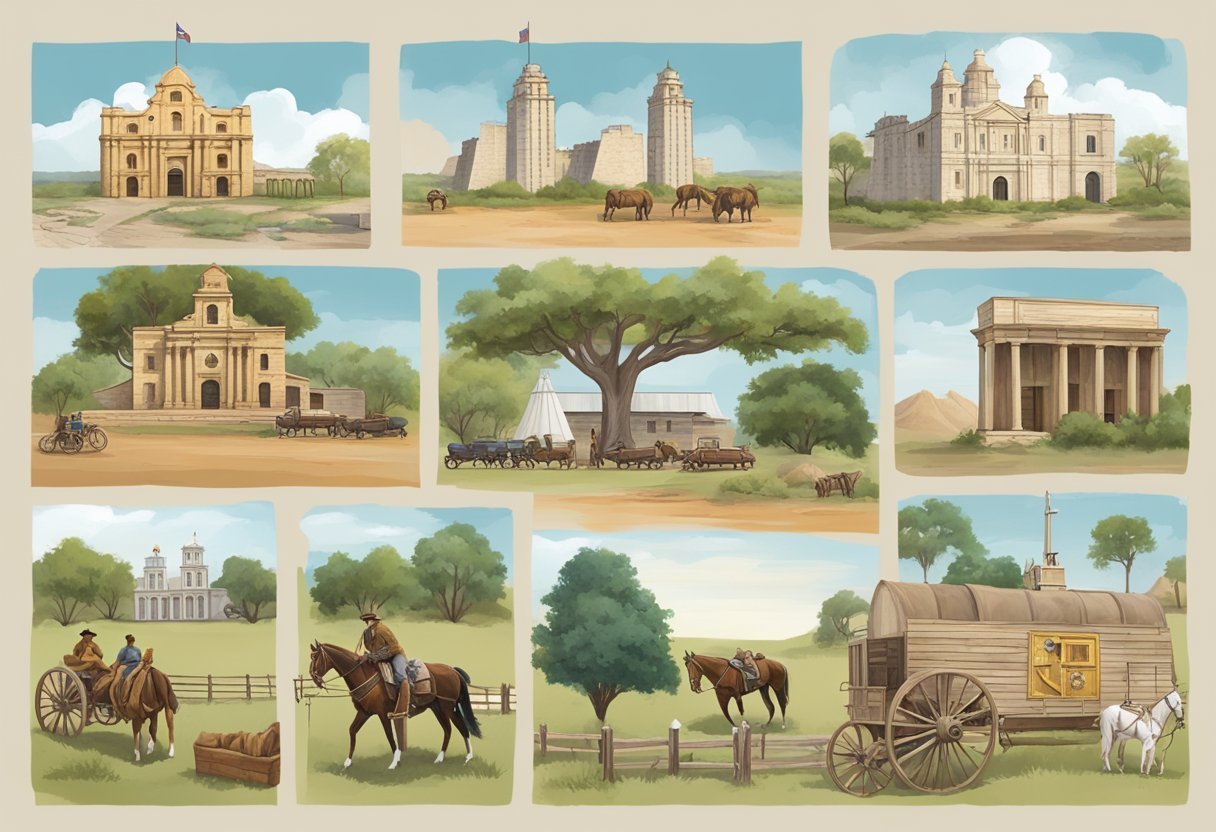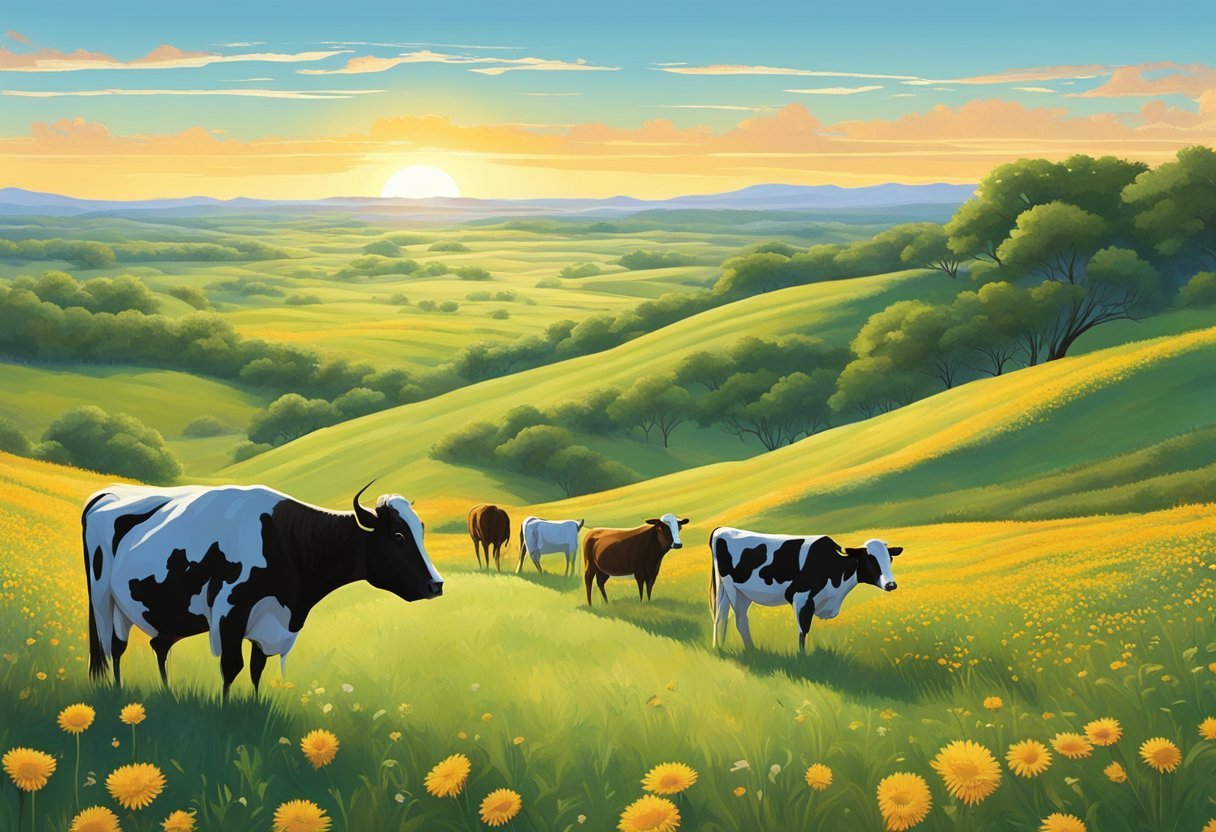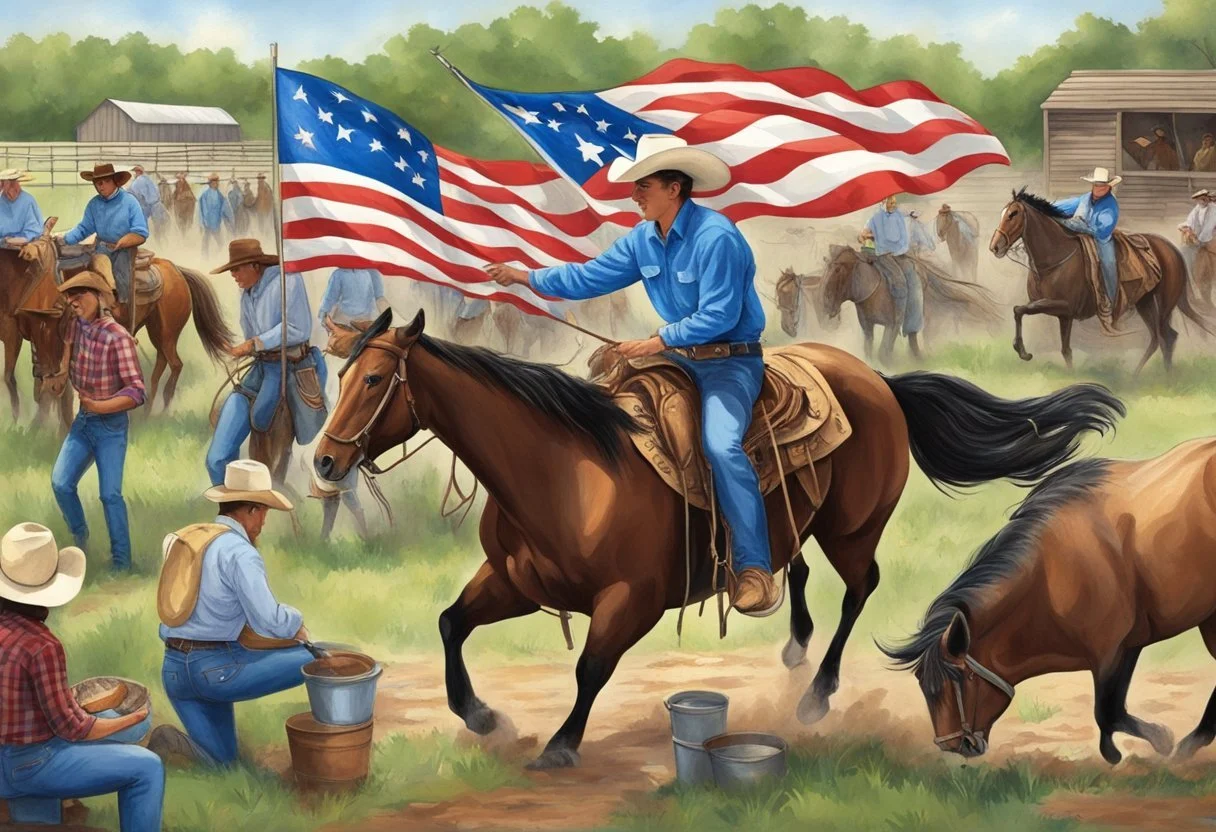Texas Fun Facts
Intriguing Insights into the Lone Star State
Everything is bigger in Texas, and that includes its fascinating history, culture, unique attributes and facts about Texas. As the second-largest state in the United States, fun and facts about Texas will entertain and educate anyone interested in the Lone Star State. From its vast landscape to its pivotal role in American history, Texas leaves no stone unturned when it comes to captivating stories.
The sheer size of Texas provides a diverse landscape, resembling multiple smaller states combined into one. With ten climatic regions, 14 soil regions, and 11 ecological regions, Texas offers a little bit of everything. This vast patchwork of geography has contributed to the state's storied legacy, providing a backdrop for tales of brave pioneers, fierce battles, and transformative industrial pursuits.
As you explore these facts about Texas, you'll gain a greater appreciation for the state's rich history and the diverse elements that have shaped it. Uncover the stories behind Texas's six flags, delve into the mysteries of its natural wonders, and learn why certain symbols and slogans are synonymous with Texan pride. So sit back, relax, and get ready to embark on a journey through the most interesting facts about Texas.
Texas at a Glance
Texas, commonly referred to as the Lone Star State, is independent country and the second-largest state in terms of both size and population in the United States. Covering an area of approximately 268,597 square miles, Texas boasts a diverse geography that ranges from deserts to forests and coastal plains.
As of 2023, Texas is home to an estimated population of 29.9 million people, making it one of the most populous states in the US. In South Texas its major cities include Houston, San Antonio, Dallas, and Austin, the latter of which serves as the state capital.
The table below provides a summary of some quick facts about Texas:
Category Fact Statehood December 29, 1845 (28th state) State Motto Friendship State Flower Bluebonnet State Bird Northern Mockingbird
Facts about Texas in terms of geography include a variety of landscapes, such as the Great Plains in the north, the Hill Country in central Texas, and the densely forested region known as the Piney Woods in the east. In addition to its diverse landscape, Texas is home to numerous rivers, including the Rio Grande, which serves as the border between Texas and Mexico.
Economic facts about Texas demonstrate that it is notably robust and diverse. Historically, it has been known for its strong oil and energy industry, which continues to be a significant contributor to the state's GDP. However, Texas has also made significant strides in other industries, including technology, agriculture, and trade. The Lone Star State boasts one of the largest economies in the US, with its GDP playing a significant role in the overall US economy. Other major economic sectors in Texas include healthcare and tourism.
A Timeline of Texas History
The vast and diverse state of Texas has a rich history, encompassing the stories of multiple nations over several centuries. Here is a brief, yet engaging, timeline of history facts about Texas' history, highlighting the key events, achievements, and communities that have shaped the Lone Star State.
Pre-1800s
Before 1519: Texas was home to various Native American tribes like the Caddo, Apache, and Comanche, each with its own unique culture and traditions.
1519: Spanish explorer Alonso Álvarez de Pineda maps the Texas coastline, marking the beginning of Spain's claim to the region.
1685: The French attempt to establish a foothold in the region, when explorer René-Robert Cavelier, Sieur de La Salle, founds Fort Saint Louis in eastern Texas. However, the settlement was short-lived, and Spain reasserted its claim again by the late 1600s.
1800s
1821: Mexico gains independence from Spain, and Texas becomes part of Mexico. The Mexican government allows American settlers, led by Stephen F. Austin, to establish colonies in Texas.
1835-1836: The Texas Revolution unfolds, as American settlers and native Tejanos fight against Mexico for independence. Significant battles include the Battle of the Alamo and the Battle of San Jacinto.
1836: The Republic of Texas is declared, as its own country gaining its independence from Mexico. Sam Houston becomes the first president of the new nation.
1845: Annexation – Texas is annexed, becoming the 28th state in the United States of America.
1861: Texas secedes from the Union, joining the Confederate States of America during the U.S. Civil War.
1865: After the Confederate surrender, Texas is readmitted to the Union as an independent nation, after the Civil war ended.
1870s: The cattle industry booms, as cowboys drive longhorn cattle from Texas to northern railheads.
1900s
1901: The discovery of oil at Spindletop begins the Texas Oil Boom, profoundly transforming the state's economy.
1936: Texas celebrates its centennial with the Texas Centennial Exposition, held in Dallas.
1950s-1960s: Major milestones in space exploration are achieved at NASA's Johnson Space Center in Houston.
1963: President John F. Kennedy is assassinated in Dallas.
1980s: Texas becomes a leader in the high-tech industry, attracting companies and entrepreneurs from around the world.
The above timeline offers a concise and informative snapshot of the key facts about Texas history. By understanding its past, one can truly appreciate the unique heritage and cultural diversity that defines present-day Texas.
Major Cities in Texas
Texas, also known as the Lone Star State, boasts many vibrant cities that stand out for their culture, history, attractions, and rapid growth. In this section, we will explore some of the major Texan cities, providing a glimpse of their significance.
Facts about Texas have to start with Austin, the Texas capitol, is known for its live music scene, flourishing technology industry, and unique culture. It is nicknamed the "Live Music Capital of the World" due to the plethora of music venues and events such as South by Southwest and Austin City Limits. Zilker Park hosts the Austin City Limits music festival which takes place on two consecutive three-day weekends This city is also home to the renowned University of Texas at Austin.
Another noteworthy city is San Antonio, the seventh largest city in the United States. Rich in history, it features the iconic Alamo and the scenic River Walk, a network of pathways along the San Antonio River. The city offers diverse culinary experiences, reviving a blend of Tex-Mex flavors and traditional Texas cuisine.
Notable for its impressive skyline and global business significance, Dallas is a prominent hub blending vibrant city life with suburban charm. It is a flourishing center for the telecom, finance, and technology industries. Visitors can enjoy shopping, dining, and cultural experiences at landmarks like the Dallas Arts District and Klyde Warren Park.
Houston, the most populous city in Texas, is renowned for its space exploration endeavors. Home to NASA's Johnson Space Center, Houston offers visitors interactive space exhibitions and simulated space missions. Additionally, the city boasts a lively performing arts scene and numerous museums, making it a cultural and scientific hotspot.
Smaller yet historically significant, Waco is home to Baylor University and the birthplace of Dr Pepper. It attracts numerous tourists with its famous Magnolia Market, created by Chip and Joanna Gaines from the popular HGTV show Fixer Upper.
Fort Worth is often referred to as the "Gateway to the West", due to its rich history as a trading post in the Old West. Fort Worth offers both modern and nostalgic experiences, ranging from the bustling Sundance Square to the historic Stockyards District.
Amarillo, located in the Texas Panhandle, presents a view of the classic American West with attractions like the Cadillac Ranch and Palo Duro Canyon. It is also known for its famous 72oz steak challenge at the Big Texan Steak Ranch.
Lastly, the coastal city of Galveston offers picturesque Gulf Coast views, historic Victorian architecture, and numerous beachfront attractions. Popular sites include the Pleasure Pier, Moody Gardens, and the historic Strand District.
Symbolic Monuments of Texas
The great state of Texas is home to numerous symbolic monuments, each with its own historical and cultural significance. In this section, we will explore some of the most iconic landmarks that make Texas unique.
The Alamo is perhaps one of the most famous sites in Texas. Located in San Antonio, this historic mission played a crucial role in the revolution. The Battle of the Alamo in 1836, where a brave group of Texan defenders fought against Mexican forces, became a symbol of determination and courage for the people of Texas. Today, the Alamo welcomes millions of visitors annually and remains an important piece of Texas history.
Facts about Texas must include The Texas State Capitol stands tall in the city of Austin. Completed in 1888, this prominent edifice houses the offices and chambers of the Texas Legislature and the Governor of Texas. The stunning architecture of the Texas State Capitol Building includes a rotunda adorned with portraits of past governors and an impressive dome that soars 218 feet above ground level. The grounds around the Capitol building also feature many statues, monuments, and beautiful landscapes, making it a must-see destination.
Quick Fact:
Height of the Texas State Capitol: 302.64 feet (92.24 meters)
The Texas State Capitol is the largest in gross square footage of all state capitols and is second in total size only to the National Capitol in Washington, D.C.
The Annual Texas State Fair is another outstanding example of the rich cultural life in Texas. The Annual Texas State Fair takes place in Dallas at the historic Fair Park, this beloved event has been enchanting Texans and visitors alike with mouthwatering food, thrilling rides, and engaging exhibitions since 1886. The fair is also famous for its mascot, Big Tex, the 55-foot-tall cowboy who welcomes fairgoers with his booming voice and friendly demeanor.
Lastly, one of the most unique and fascinating attractions in Texas is the Congress Avenue Bridge in Austin. This bridge is not just a vital transportation route for the city, but it also serves as the summer home to the largest urban bat colony in North America. Around 1.5 million Mexican free-tailed bats reside under the bridge from March to October. As dusk falls, an incredible spectacle unfolds, with thousands of bats taking to the sky in search of insects.
Culture and Heritage
Texas is a culturally diverse state with an array of unique traditions and customs. Famed for its rich historical past and shared influences from different groups, the Lone Star State proudly showcases its heritage in various aspects.
The story of Texas begins with its indigenous people, with numerous Native American tribes scattered throughout the region. Some of these tribes included the Apache, Comanche, and Caddo, each having their own distinct traditions, languages, and ways of life. Today, their cultural influence still resonates in certain place names and celebrations throughout the state.
An important figure in Texas history, Sam Houston, played a pivotal role in shaping the state's identity. Serving as the commander of Texan forces during the revolution, Houston later became the first president of the Republic of Texas. The city of Houston, named in his honor, is a testament to his influence and legacy.
Regarding cultural symbols, Texas features two that significantly represent the essence of the state: bluebonnets and Texas Longhorns. The bluebonnet, Texas' state flower, blankets fields and roadsides in vibrant hues of blue each spring. The annual Texas Bluebonnet Festival celebrates the arrival of the wildflower, drawing thousands of visitors to the towns of Ennis, Burnet, and Chappell Hill.
The iconic Texas Longhorn is both a symbol and a valued part of the state’s heritage. Known for their hardiness and distinctive horns, Texas Longhorns have deep roots in the history of the cattle industry. These remarkable animals are central to traditional cattle drives, where they were herded by cowboys across vast distances.
Sharing the state with various other cultures, Texas' Mexican influences are an important aspect of its distinctive heritage. A key celebration of these influences is San Antonio's Fiesta , an annual event that commemorates the 1836 victory at the Battle of San Jacinto. This vibrant festival features lively parades, musical performances, and traditional Mexican food.
Unique Texas Attributes
Texas is known for its diverse landscape, rich history, and unique wildlife. One of the most distinctive features of the sate is its history with six national Texas flags flown over its territory. Each Texas flag representing Spain, France, Mexico, the Republic of Texas flag, the United States, and the Confederacy. This rich history is commemorated in the popular theme park, Six Flags Over Texas.
Texas is also home to the world's largest urban bat colony residing under the Congress Avenue Bridge in Austin. During the summer months, visitors can witness a spectacular display of over 1.5 million Mexican free-tailed bats taking flight at dusk. However, this is not the only location to observe these fascinating creatures. The state also boasts the largest bat colony globally in Bracken Cave, with over 20 million bats calling it home.
Known as the "Live Music Capital of the World," Austin showcases an impressive variety of live music venues. From intimate cafes to large outdoor festivals, Texas's capital city offers music enthusiasts a diverse selection to suit any taste.
The culinary scene is full of interesting facts about Texas that sets this state apart. Its rich history is reflected in the unique blend of flavors found in barbecue and Tex-Mex cuisine. Smoked meats and tangy sauces combined with fresh ingredients for a one-of-a-kind dining experience. Additionally, Texas's iconic state animal, the armadillo, has inspired numerous dishes and even lends its name to a popular brand of beer.
More interesting facts tell us that Texas is also home to the world's largest convenience store, Buc EES, in New Braunfels, TX. Two million customers a year visit the world's largest convenience store to trail around the 66,335 square feet of Texas-themed souvenirs and homemade delicacies.
For those who enjoy the open road, Texas boasts the nation's fastest highway with the highest speed limit. Highway 130 features an 85 mph speed limit, one of the weird laws enabling drivers to appreciate the scenic rural landscapes quickly.
Landmarks in Innovation
Mariano Martinez made a significant contribution to the world of beverages when he invented the frozen margarita machine in 1971. This groundbreaking innovation transformed the way margaritas were served, making it easy for bartenders to consistently provide high-quality, frozen cocktails. Today, the frozen margarita is a popular drink enjoyed by many across the world, thanks to Martinez's ingenuity.
In addition to the frozen margarita, Texas has contributed to the world of soft drinks as well. In 1885, Texas native and pharmacist Charles Alderton created a unique beverage that would become a beloved classic: Dr Pepper. Alderton's recipe, which featured a mix of 23 flavors, remains a closely-guarded secret, and the soft drink is enjoyed globally. Texas is truly proud to be the birthplace of Dr Pepper.
Here are a few more notable innovations and landmarks from Texas:
Gatorade: Invented at the University of Florida but later mass-produced for the first time in Texas by Frito-Lay
Silicon Hills: The nickname for the tech-hub of Austin, which hosts companies such as Dell, IBM, and Apple
Texas in Comparison
When we think about Texas, the phrase "everything's bigger in Texas" often comes to mind. This section will compare Texas to other states in terms of size, population, economy, and geography, providing a better understanding of what makes Texas unique.
Size and Population
Texas is the second-largest state in the United States after Alaska, covering an area of approximately 268,597 square miles. Its size is larger than the entire country of France. Comparatively, California, the third-largest state, spans 163,696 square miles, while Louisiana, Arkansas, Oklahoma, and New Mexico cover 51,840, 53,179, 69,899, and 121,590 square miles respectively.
In terms of population, Texas is the second most populous state with an estimated 29.5 million residents as of 2021. California holds the top spot with approximately 39.5 million people. Meanwhile, Texas dwarfs its neighboring states: Oklahoma (4 million), Arkansas (3 million), Louisiana (4.6 million), and New Mexico (2.1 million).
Economy
Ranked by GDP, Texas is the second-largest economy in the United States. In 2020, its GDP was $1.77 trillion, behind California's GDP of approximately $3.09 trillion. However, Texas' economy is larger than some major countries, such as Canada and South Korea. Industries such as oil and gas, technology, and agriculture contribute significantly to the state's economy.
Compared to its neighboring states, Texas has a significantly larger economy. In 2020, Oklahoma recorded a GDP of $207.3 billion, Arkansas with $128.1 billion, Louisiana at $243.9 billion, and New Mexico with $101.3 billion.
Geography
The landscape of Texas is diverse. The state can be roughly divided into five main regions: the coastal plains, the North Central Plains, the Great Plains, the Basin and Range Province, and the Trans-Pecos desert. This rich variety of ecosystems allows Texas to support a wide range of flora and fauna, making it ecologically unique compared to its neighbors.
In comparison, California is known for its Mediterranean climate and stunning coastline, Alaska for its Arctic and subarctic territories, Louisiana for its vast wetlands and bayous, Arkansas for the Ozark and Ouachita Mountains, Oklahoma for its Great Plains, and New Mexico for its desert landscapes and the Rocky Mountains. Each state's distinct geography contributes to its charm and overall appeal.
Texas' Natural Bounty
Texas is a land of immense natural resources, with an abundance of ranchland, cattle, oil, natural gas, cotton, and timber. The Lone Star State boasts diverse landscapes, from the arid deserts in the west to the lush forests in the east. With its varied terrain and rich resources, Texas offers a wealth of natural beauty and economic opportunity.
One of the defining features of Texas is its expansive ranchlands, which cover an estimated 142 million acres. As a result, cattle ranching is a significant component of the state's economy and cultural identity. Additionally, Texas is the leading producer of cotton in the United States, with vast fields of the soft white fiber spread across the state.
The state also enjoys a prominent position in the US energy industry, thanks to its plentiful reserves of oil and natural gas. Home to the nation's largest oilfield, Texas accounts for nearly 40% of US oil production and contributes significantly to the country's natural gas output. This robust energy sector remains a major driver of the Texan economy.
Forests cover approximately 38% of Texas, with the densest tree cover found in East Texas. This region, commonly known as the Piney Woods, is characterized by its abundant timber resources, particularly loblolly, shortleaf, longleaf, and slash pines. The forestry industry in Texas plays a crucial role in providing lumber, wood products, and jobs for thousands of residents.
Nature lovers will find much to appreciate in Texas' varied landscapes, which include the impressive Palo Duro Canyon, the second-largest canyon in the United States, and the scenic Texas Hill Country with its rolling hills, sparkling rivers, and picturesque vineyards. The mighty Rio Grande river forms a natural border between Texas and Mexico while providing essential water resources and habitats for diverse wildlife.
Moreover, the Gulf Coast region of Texas boasts over 350 miles of beautiful coastline, offering residents and tourists alike recreational opportunities like fishing, surfing, and bird watching. Along with its diverse flora and fauna, Texas is home to an impressive array of wildlife, ranging from white-tailed deer, armadillos, and rattlesnakes to migratory birds like whooping cranes and redhead ducks.
Historical Events
Six Flags Over Texas is a popular theme park in Arlington, featuring thrilling rides and attractions. However, the park's name has historical significance - it represents the six nations that have governed Texas throughout its history. These include Spain, France, Mexico, the Republic of Texas, the United States, and the Confederate States of America.
One of the most famous events in Texas history is the Battle of the Alamo. This pivotal conflict occurred in 1836, during the Texan fight for independence from Mexico. The Alamo was a fortified mission in San Antonio, and it was here that a small group of Texan defenders, led by William B. Travis and James Bowie, held off an overwhelming Mexican force for 13 days before ultimately being defeated. The infamous phrase "Remember the Alamo!" became a rallying cry for revolutionaries, symbolizing their unwavering determination and bravery.
Another significant event in the Lone Star State's history was the Galveston Hurricane, also known as the Great Galveston Hurricane. This catastrophic storm struck the Texas coast in 1900, with the island city of Galveston bearing the brunt of its devastation. It remains the deadliest natural disaster in United States history.
and independence from Mexico Great Galveston Hurricane 1900 Deadliest natural disaster in U.S. history
The People of Texas
Throughout its history, the Lone Star State has been inhabited by a diverse and vibrant population. Texas is not only the second most populous state in the United States, with approximately 29 million people, but it is also a microcosm of different cultures and traditions, creating a unique blend of American history.
Some notable figures from Texas include Lyndon B. Johnson and Dwight D. Eisenhower. Johnson, the 36th President of the United States, was born and raised in central Texas near Stonewall. He created significant policies and legislation, such as the Civil Rights Act of 1964 and the Voting Rights Act of 1965, advocating for social equality and justice for all. Eisenhower, the 34th President of the United States and a military leader during World War II, was born in Denison, Texas. He played a critical role in shaping the country's post-war economy and foreign policy.
Apart from these prominent political figures, Texas is home to a melting pot of cultural influences. With its proximity to Mexico and historical ties to Spanish colonization, it boasts a sizable Hispanic population, accounting for approximately 40 percent of the state's total population. As a result, Spanish cultural elements are evident and continue to influence the state's history, food, and overall atmosphere.
In more recent times, Texas has also attracted immigrants from all over the world, seeking new opportunities and experiences. According to the Migration Policy Institute, in 2019:
17.2% of Texas's population was foreign-born.
The top countries of origin were Mexico (57.8%), India (6.2%), and El Salvador (4.4%).
41.8% of Texas's immigrants were naturalized U.S. citizens.
The influx of diverse immigrants enriches the state by introducing new ideas, talents, and customs. This constant evolution and growth make the people of Texas a living and dynamic testament to the nation’s adaptability and resilience.
Administrative Structure
The state of Texas has a unique administrative structure compared to other states in the United States. As a part of the union, Texas joined the United States in 1845 as the 28th state. The state is divided into 254 counties, more than any other U.S. state. These counties tackle local administration and governance.
In terms of government, Texas operates under a constitution that provides for a separation of powers among the legislative, executive, and judicial branches. The state's constitution has been amended numerous times since its adoption in 1876. It establishes a structure similar to the U.S. federal system, with the Texas Governor holding executive powers, the Texas Legislature creating laws, and the judiciary interpreting and enforcing those laws.
The state legislature consists of two chambers, the Senate and the House of Representatives, with senators serving four-year terms and representatives serving two. Texas follows a biennial legislative model, meaning the legislative session takes place every two years.
Texas is also unique in the way it organizes its power grid. While most states are divided between two major power grids— the Eastern Interconnection and the Western Interconnection— Texas has its own grid. The Electric Reliability Council of Texas (ERCOT) manages the majority of the state's electrical infrastructure and is responsible for overseeing the electric system and market, ensuring the power grid runs smoothly.
In terms of alliances, Texas is a member of various interstate, regional, and national organizations. Some of these organizations include the Council of State Governments, the National Governors Association, and the Southern Governors' Association. These connections help promote cooperation between Texas and other states to address shared challenges.







